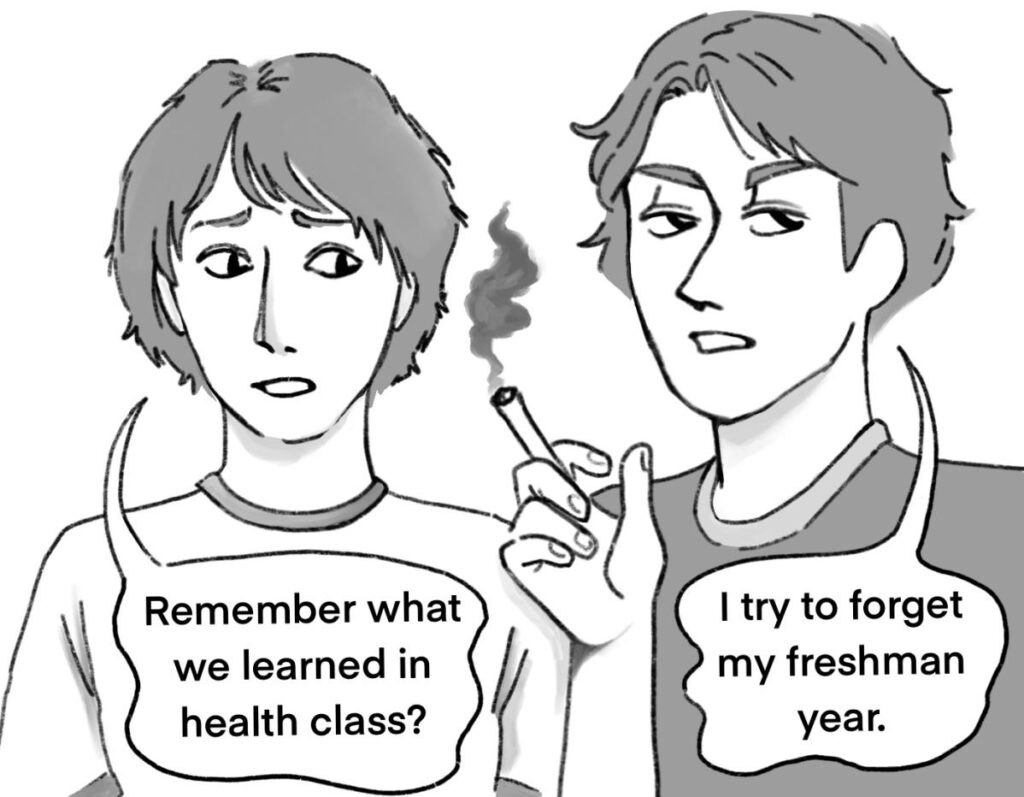
Alexa Sterry
This editorial represents the unanimous opinion of all 15 Outlook editors.
For the past four issues, the Aragon Outlook has covered student substance abuse and addiction, including marijuana, alcohol and nicotine in the “Hooked” series, as well as psychedelics. With 154 student referrals from the district this year to substance abuse interventions, it’s abundantly clear that substance use has become an inherent part of Aragon culture and society at large. Some students battle peer and familial pressure to use substances, or turn to them as coping mechanisms — casual usage turning into a dependency or, in some cases, addiction.
In light of the stories we’ve uncovered, sources we’ve spoken to and ever-growing statistics featured in the centerspread on page 8-9, the editors of The Aragon Outlook believe that Aragon should expand upon its existing support for students battling addictions and focus on preventative education.
When students are caught with substances on campus, punishments vary situationally and seldom involve the police.
The San Mateo Union High School District uses Alternative to Suspension programs, which are one-on-one or group therapy sessions. They emphasize increasing student awareness about the risks of substance abuse rather than punitive punishment. One such example is a two-week-long group session on Monday evenings for students who are caught using or possessing nicotine.
However, these support resources should be available to students who reach out wanting to quit — not just those who are caught with substances.
Though students learn about substance abuse in freshman health classes, The Outlook believes that further education is necessary. Those in ATS work with outside therapists and community partners, learning from experts about substance abuse. This should be incorporated into the health curriculum itself, in the form of guest speakers, panel discussions, Q&A sessions or a lecture series. Instead of educating students correctively, more efforts should be made preventatively.
“These are 14 to 18-year-olds who are curious,” said former Aragon health teacher Malcom Davis. “If you’re making that decision to try something, you need to know the consequences of that decision as well. Not just the effects of the drug, but also [what] can happen to you. As teachers and staff, we can’t control what you do outside of school, but we can hopefully educate you and make sure that you understand the possibilities of danger that you’re putting yourself in.”
Health classes offer an important introduction, but have to cover a significant amount of material in a single semester including nutrition, physical exercise, suicide prevention, chronic diseases and addictive substances. Consequently, there isn’t enough time to fully educate students on each topic.
Moreover, according to the National Institute on Drug Abuse, substance abuse increases between freshman and senior year of high school, with 31.2% of American twelfth graders reporting substance use in comparison to 19.8% of tenth graders. This, combined with the fact that substance abuse education is always changing, means that more education is necessary after freshman year.
“We target the freshmen, and we hope that this 14 or 15 year old remembers this until they’re 18,” Davis said. “But our target emphasis should be on continually teaching the sophomores, the juniors and the seniors about addiction, [not] just the freshmen.”
This could be in the form of assemblies or a mandatory refresher course for upperclassmen to emphasize the content of previous health classes.
Furthermore, Aragon must destigmatize reaching out for support around drug use. If students could access help without feeling as if they’d get in trouble, or be judged by adults and peers, we can combat substance abuse before it grows into a harmful addiction.
“I don’t think you get anywhere by making teenagers feel judged, like they’re ‘bad’ for what they did, or that they’re just being dismissed as doing ‘what teenagers do’ and that they’ve ‘got to get it together’ and all that stuff,” said Wellness Counselor Jillian Ma. “There’s legal parameters we have to follow, [like] we have to let parents know, but within those parameters it’s really important to be curious and to move towards repair as opposed to punishment.”
Dialogue, specifically, is key to breaking down the stigma around addiction.
“It’s extremely common in general to experiment as a teenager – I smoke and drink on the weekends with my friends, and I know a lot of my classmates do as well,” said an anonymous senior. “I don’t hear a lot of open conversation between teachers and students about it, and I wish I did because some of my friends have become so dependent. Having dialogue around it would make students more likely to reach out for help because they wouldn’t feel so alone, and learn that there is help for them if they need it.”



